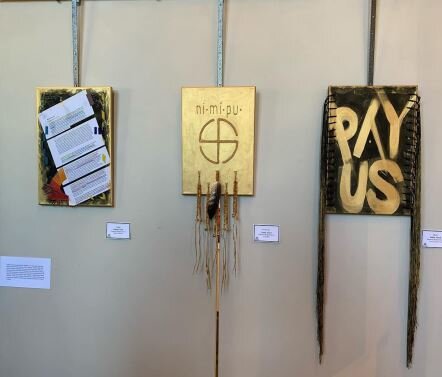Kellen Trenal’s latest collection, Treatyz. His pieces focus on the treaties of 1855 and 1863 that have shaped Nimiipuu history. The pieces symbolize his interpretation of those treaties and are on display at the Josephy Center. (Photo by Kellen Trenal)
JOSEPH- A small celebration took place featuring Nimiipuu artists at the Josephy Center for Art and Culture in Joseph, Oregon. A group of seven Nez Perce artists and writers who call themselves luk'upsíimey “North Star" Collective, gathered at the Nez Perce Wallowa Homeland for a week, practicing their art, learning and relearning their language together. They are college professors and language teachers, visual artists and wordmakers. They traveled from California, Arizona, Philadelphia and Lapwai. They came together at Wallowa, the place that echoes their ancient common Nimiipuu language. On July 23, Nimiipuu artists such as Kellen Trenal and Phil Cash Cash, writer Beth Piatote and other Nez Perce writers and speakers read and reflected on their individual work as it relates to maps, words, and images of the current exhibit, “Nez Perce Treaties and Reservations, 1855-Present.” Trenal is a multitalented Nez Perce performer and a visual artist. He’s a master beadworker and has his own podcast that raises awareness for Black and Indigenous cultures and communities. Cash Cash, who co-authored a book of area place names, is CayuseNez Perce and enrolled Umatilla. Beth Piatote has written poems, plays and academic texts about the Indian experience. Along with other Nez Perce speakers, they spent a week in their own “language camp” in the land of their ancestors. “I’ve been at this Josephy Center work for almost ten years. We’ve been successful as an organization, making our way through the pandemic with virtual and hybrid programs about Covid and Fire, Natural Resources and the local health care system, making and giving away over 1000 art bags with individual supplies and art projects to children and parents,” said Rich Wandschneider. “But this exhibit and Friday night’s words and music have been a highlight for me, and the surest proof that our work is important,” he added. People are becoming more aware of the actual history that occured to the Nez Perce people, reading the words of the exhibit, seeing how the settlers and U.S. Government contributed to Native Nations losing their lands and how promises were made and not kept, how hopes were dashed and treaties were put into place with words unfamiliar to tribes. Awareness on the Nez Perce War of 1877 was highlighted as well. Attendees learned how the words of the same treaties still have legal currency today, and the Nez Perce are fishing, hunting, and gathering as they always did in their “usual and accustomed places” as promised nearly 150 years ago.
